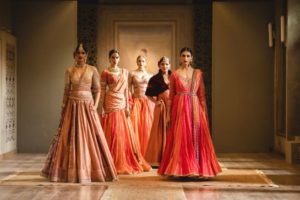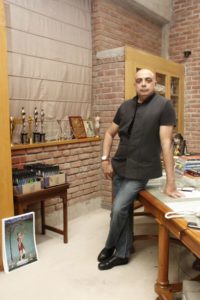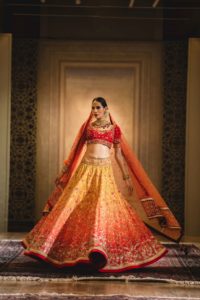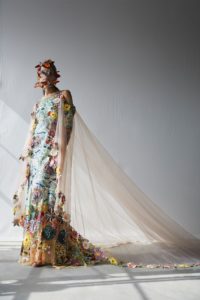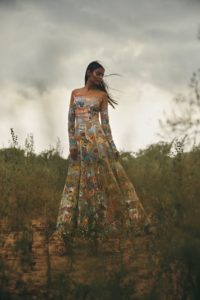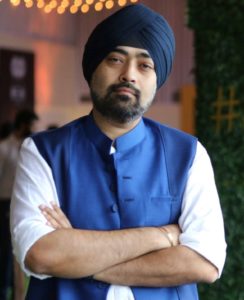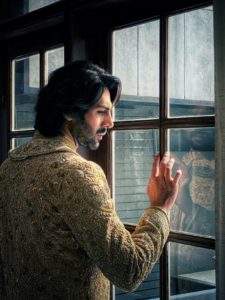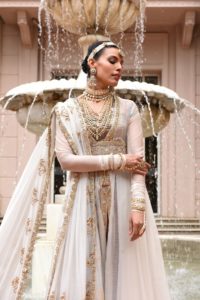Tarun Tahiliani, Festive Wear
LuxuryNext presents an exclusive on Digital Fashion Shows and Multi-Dimensional Fashion Films. Deepali Nandwani in conversation with Indian designers Tarun Tahiliani and Rahul Mishra, as well as Jaspreet Chandok, Head – Lifestyle Businesses, IMG Reliance (which hosts LFW), about the future of digital fashion.
In July 2020, Ermenegildo Zegna’s Artistic Director, Alessandro Sartori, had experimented with the digital format. The Spring/Summer 2021 collection was inspired by the Zegna Oasis and immersed virtually in the nature reserve, near the headquarters of the brand in Trivero, in Italy.
“It was almost like a digital movie. A blend of live performance with a pre-recorded environment, hosted using CGI technology where you layer frames one over the other. Live models were wearing the collection. But instead of just the normal runway, with just me in an empty space with the models, we worked towards a live experience in a really special environment,” explained the designer.
Clearly, it is the era of physical-meets-digital is the future of fashion and ramp shows. Indians have taken to the format with gusto, hosting their own versions of phygital shows. In India, the Lakmé Fashion Week innovated new digital formats and experiences.
Deepali Nandwani in an exclusive talk with Indian designers Tarun Tahiliani and Rahul Mishra, as well as Jaspreet Chandok, Head – Lifestyle Businesses, IMG Reliance (which hosts LFW), about the future of digital fashion.
Tarun Tahiliani
Tarun Tahiliani: “Digital shows will never be able to replace the physical ones”.
Can the phygital/digital show replace the kind of experience that an actual physical on-ground fashion show offers?
Tarun Tahiliani (TT): Watching a fashion show on your laptop screen or phone is not even a patch on attending a show – there is no question about that! A live show is immersive; there is a scintillating buzz that emanates from there being a live audience. A live show typically involves an imposing set, elaborate lighting, multiple models and the theatrics. All of these contribute hugely to a spectacle that can never be replicated digitally, unless your venue is an iMax theatre, and even then, in today’s world, that is replete with so much augmented reality, nothing quite compares to the sheer joy of seeing fashion in a ‘live’ format.
Tarun Tahiliani Bridal Wear
In any case, even when we do put on live shows, there are maximum 400-500 people – including the media – in attendance and most of the world consumes them digitally. So, really, with the exception of those 400-500 people, everyone would be privy to the same experience that they would normally have.
A virtual fashion week would definitely be missing so many elements that make up the buzz of a real fashion week. That said, given the times we live in, a virtual fashion week is far better than having no fashion week!
Rahul Mishra
Rahul Mishra (RM):
Fashion weeks are more than just shows – there is an entire ecosystem around them – the stores, clients, the dealers that you meet, the networking, etc. How important are they to the fashion business? What could their future be, given many international brands have decided to pull out of fashion weeks, not just this year, but even maybe for the future?
Sadly, in my opinion, fashion weeks in India have become big corporate events that heavily rely on Bollywood celebrities to attract eyeballs. This has resulted in less-serious fashion media reportage because there is a dearth of thoughtful critique, questions about relevance and qualitative judgement. I suppose the whole world has turned towards economics, advertising and promotion.
Back in the day, fashion shows were usually restricted to a fairly limited audience; there was discernment and there was inbuilt judiciousness in the mechanism and quality was perceived up close. Be that as it as it may, those shows were still spectacles in their own right.
I feel that the way we are approaching the notion of ‘fashion weeks’, we might have come to a stage beyond which an idea is explored for the sake of an idea. If we are to talk about sustainability then we also need to think about the longevity of clothes and there are many brands who have done that very beautifully like Max Mara and Armani, where it is not about absurd styling statements but collections that build upon each other. India is a classical culture heaving under her own modernity. As always, there will be different strokes for different folks and we will see how this evolves.
These conversations about how fashion weeks put undue pressures on designers, given the number of fashion weeks we have and the number of collections that have to be made. How true is that and can fashion weeks of the future be rationalised?
As we have recently concluded our virtual showcase and in light of the fact that we are working with a limited amount of stock, our focus will now be on trying to ensure that all interested customers have access to selected items from the collection, which will travel between the different stores so that our local clientele in our key markets can have access to it.
The big upside to a virtual showcase is that besides the reduced stock that will be available in stores, most of the garments will be made ‘by-order’, which essentially means that customers will be getting couture service at ready-to-wear price points. We also feel that by manufacturing clothes for people by-order, we reduce the risk of store samples being tried-on by multiple people; this is a considered decision bearing in mind the safety of our customers and limiting our exposure to anything untoward.
In any given crisis, there has to be a silver lining and we believe that this is the best solution for us. Once we have vaccines and the world returns to ‘normal’, we will obviously re-evaluate our strategy but it is too early to comment on that at this stage.
Rahul Mishra: “10 seconds of a garment fleeting past you on the catwalk can effectively be replaced with multi-dimensional fashion films.”
How do you look back at the last five months in terms of its effect on the Indian fashion industry?
The Indian fashion industry, alongside the designer brands, represents millions of regional craftsmen and a large chunk of local businesses. During the initial months of the pandemic, a bold economic impact was observed, but a larger impact has been the psychological one. While several of the local craftsmen found themselves in danger of losing their livelihoods, the manufacturers, designers and fashion brands realised their role as the backbone of the industry.
People observed how nature healed itself and COVID, being the great leveller, impacted everyone without discrimination. This has instilled a new sense of empathy in people’s hearts towards our fellow humans and natural resources. Consumers are looking to invest in fashion that holds artisanal and emotional value. I observe consciousness towards supporting small businesses and the local economy. This pandemic will serve as a reminder that the way we went about things in the past wasn’t right for the planet and if the change has to be made, it must be now.
There has been a visible incline towards sustainable practices and every brand intends to explore a more conscious approach. The Indian fashion industry may move in the direction of mindful luxury that finds its genesis in a larger purpose. At least for some time, designers may seek to instill personal and emotional value in their garments, with emphasis on craftsmanship.
With the evolution of the phygital experiences, would fashion weeks die a slow death or will they evolve?
Once, I was a purist. I felt that physical shows, with their multi-sensory experience and immersive set-ups, are the ideal way of presenting a collection. But I must say, it was quite a unique experience to showcase digitally. Almost the same amount of work and stress went behind (our digital showcase) and there was a level of nervousness I experienced right before the live stream.
I feel that only 10 seconds of a garment fleeting past you on the catwalk can effectively be replaced with these multi-dimensional fashion films that can zoom-in to all the details a designer wants to showcase. The online showcases have allowed us to compensate for the backstage conversations with journalists and reimagine the way we tell our story.
This way, everyone gets front seat access to the collection. This kind of storytelling is effective and shall continue to be relevant when brands aren’t dependent on it. The technical tools offer a replacement to the in-store experience, in a situation the latter is inaccessible. Considering that this medium isn’t a complete replacement for physical shows, it will open several doors to up-and-coming designers in building a communication model and to facilitate effective interaction with their patrons.
The Indian fashion industry functions quite similarly to that of Europe or America. While a majority of the market here is dominated by occasion and bridal wear, we have a defined fashion cycle that functions in an equally organised manner. The Indian luxury consumer is familiar with the international ways of retail. With many designers successfully retailing through social media and website collection launches, the lack of fashion weeks shall be easily adapted to.
There have conversations around undue pressures put by fashion weeks on designers to produce multiple collections a year. How does that play out in your career as a designer?
I believe in creating fashion that is independent of trends and season. Our focus is on creating a maximum of two collections a year and showcasing parts of it during various fashion showcases when required. The key is for a designer to identify their larger purpose behind creating their product, which for us, is the employment and empowerment of craftsmen.
Jaspreet Chandok
Jaspreet Chandok, Head – Lifestyle Businesses, IMG Reliance: “The Virtual Showroom at Lakmé Fashion Week 2020 has transformed the otherwise offline procedure to completely digital, allowing many fashion buyers to be exposed to all participating designers.”
Can you give me a lowdown on what went into organizing the first digital fashion week?
If you visit the Hub, our platform online, it provides you with all the touchpoints that you would engage with in an on-ground experience including sponsor installations. We also have been the first in the world to create an architecture that supports multi camera view choices across our showcases. The fact that you can “shop directly off the runway” is another innovation that helps designers and consumers engage in a stronger manner.
Bollywood’s favourite Kartik Aaryan featured as a muse for Manish Malhotra at LFW 2020
What went into setting up the virtual showroom? What has been the response been like?
With the help of our technology partners, we were able to setup the Virtual Showroom, a first of its kind concept in India to support the business of fashion. We have seen an overwhelming response from designers as the Virtual Showroom makes it accessible for buyers to reach them directly. The fact that the Showroom is also linked to the Lakmé Fashion Week Hub, it enables buyers to seamlessly go from watching a show, to placing an order. We continue to monitor sales for now as most engagements are currently ongoing.
Have you seen the regular buyers at LFWs log into the digital fashion week?
Absolutely. The Virtual Showroom at Lakmé Fashion Week 2020 has transformed the otherwise offline procedure to completely digital allowing many fashion buyers to be exposed to all participating designers and their collections on a fast and fluid platform that is responsive and mobile friendly. And we also strategically chose these dates to collide with the festive season which always helps.
Manish Malhotra at LFW 2020
What have been the roadblocks and challenges?
While a large cross-section of the universe is now quite tech savvy, any new medium requires some time before people embrace the platform. Obviously, the industry itself is struggling and we felt that the investments need to be made in actions that genuinely assist the industry. This first season is seeing a lot of experimentation as designers are trying out different ways to build businesses through our platforms. Audience & consumer feedback will define what we take forward and build on.
Do you see some form of digital fashion week continue to endure even when the world opens up normally? Will fashion weeks be hybrid digital-meets-physical in the future?
We actually began our journey towards being a digital platform many years back so some of the actions were already in the works when the pandemic hit. We were the first fashion week in the world to Live Stream on OTT networks also creating innovations in social media actions and virtual reality.
A key decision of investments this season where on actions that are less reactionary and more strategic. Hence the creation of the Hub, Virtual Showroom, Vantage point views & See Now Buy Now will also expand themselves and become key actions in the years to come. Even when we return to a physical event, all these elements become companion actions adding to the overall product offering to consumers.
We see this season as a pilot and we are happy to get feedback from all stakeholders and continue the development of all these digital initiatives.
What do you miss most about the physical fashion weeks?
Technology has opened a lot of avenues in the world of fashion, but we doubt it can completely replace the experience of a physical show. The audience loves to engage in the runway experience, and we will hopefully see more phygital showcases once things start getting back to normal.

